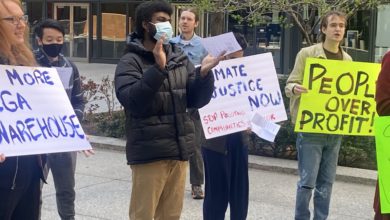There is an environmental disaster quietly unfolding in the Cuyahoga River in Cleveland. The Sherwin-Williams Technology Center plant is the source of an oil spill that occurred after the site’s generator suffered what the company called an “acute diesel fuel line failure” on Jan. 22. The oil flowed into a storm drain before traveling directly into the Cuyahoga River. Sherwin-Williams is a massive corporation, primarily known for manufacturing and selling paint.
According to a statement released to local media, 60 to 100 gallons of diesel fuel flowed into the Cuyahoga River. Sherwin-Williams did engage in some clean-up, largely by hiring a third-party company called HEPACO, the same company that profited off the incomplete and insufficient clean up after the East Palestine derailment. HEPACO was paid by Sherwin-Williams in an effort to retrieve the remaining diesel fuel in the storm sewer line.
Following the spill, the Ohio EPA made the claim that the gallons of diesel in the Cuyahoga River had “no impact to drinking water.” They additionally claimed that there was “no evidence of sheen on the river near the spill.”
But according to local environmental activist Eddie Olschansky, who is on the river kayaking at least five days a week with his organization Trash Fish, Sherwin-Williams has not remediated the issue despite their claims and the claims of the EPA. In videos recently posted by Olschansky, a sheen from the fuel was still visible on the water. Considering the discrepancy between this and Ohio EPA’s claim that there was no sheen on the river in that area, it makes the EPA’s claim that the spill had made no impact to the water dubious at best.
Sherwin-Williams has a well-known history of inflicting environmental damage, but it also engages in deliberate oppression of the working class in Cleveland.
Sherwin-Williams and class warfare in Cleveland
Sherwin-Williams is one of the largest employers in Cleveland, where its headquarters employs 4,185 workers. The company already engages in practices that target and oppress based on both class and race. In 2020, the company disposed of all its union janitors with combined decades of experience to replace them all with non-union janitors. Ruth Young, a janitor, wrote about this greedy mass firing in Crain’s Cleveland Business. Young pointed out that all the janitors employed there were Black and Latino. The decision left them all scrambling for employment during the onset of a global pandemic. That same year, Sherwin-Williams had to settle for millions with workers in California for non-payment of overtime, meal breaks and rest periods.
Just last month in Dallas, an explosion at a Sherwin-Williams plant endangered the lives of workers. This explosion was no mere accident, but the result of repeated neglect. In its report, OSHA “found nine violations, including a repeat violation for not inspecting processing equipment, such as pipes that exposed workers to hazards.”
Cleveland recently gave the company a $100 million tax abatement for their new headquarters. The interview with Olschansky raises suggests that the people of Cleveland are getting terrible deal, as their tax dollars directly benefit Sherwin-Williams. while the company poisons water sources and abuses the working people. Tax dollars even fund these clean-ups!
Cuyahoga River fires: a legacy
Considering the Sherwin-Williams’ oil spill in the Cuyahoga River in January, a broader discussion on Ohio’s history of environmental disasters — particularly ones resulting from corporate greed — is pertinent.
The Cuyahoga River’s path through Cleveland has long been a site of environmental concern. The United States would not have environmental law as we know it without responses to the corporate greed of the Cleveland business community. The Clean Water Act of 1972, a cornerstone of U.S. environmental law, sprung up alongside mass activism in wake of the Cuyahoga River fire in 1969. The event additionally birthed the Environmental Protection Agency.
However, as soon as Ronald Reagan took office, not a decade after its creation, the U.S. government began the task of gutting the EPA. The ruling class has done its best to fill it with corrupt administrators and lobbyists from fossil fuel and chemical industries. This corruption continues cropping up within the EPA, and its ability to protect human life and environmental health has been defanged entirely. It has been perfectly reformed by the bourgeois government to be “hemmed in,” as Lenin said in State and Revolution, “by the narrow limits set by capitalist exploitation.”
In 2022, the Supreme Court ruled that the EPA lacks the authority to “adopt on its own … a regulatory scheme” which caps “carbon dioxide emissions.” The Court determined that Congress — a club of political elite who have never had the best interests of the oppressed in mind — would have sole authority to design these regulatory schemes.
In 2023, the Supreme Court destroyed the EPA’s capacity for guarding water quality. According to Clean Water Action, the Court’s ruling in Sackett v. EPA left “at least half of our nation’s remaining wetlands” unprotected by the Clean Water Act. While leaving our waters thoroughly unprotected, the Court “invited fossil fuel and mining companies, real estate developers, and industrial agriculture to pollute, bulldoze, fill in, or drain these invaluable water resources.” The Supreme Court has determined that the continued mega profits of the ruling class weren’t enough, deciding to sacrifice the whole country’s health on the altar of corporate greed.
The degree to which your local environment is protected is deeply intertwined with issues of class and race. Water, one of life’s greatest necessities, has its quality determined along class and race lines in capitalist nations like the United States, with the worst conditions being intentionally relegated to Black and Indigenous communities. Last year, the Supreme Court effectively ruled that the Navajo Nation does not have the right to clean water.
A Michigan Civil Rights Commission Report said “systemic racism” was at the root of the Flint, Michigan, water crisis. Flint is majority Black. While a United Church of Christ report said that Northeast Ohio’s poorest communities are hotspots for environmental injustice.
Whether you get access to clean drinking water is determined by the whims of the cruel and racist ruling class and their business interests. Oil spills, such as the one on the Cuyahoga River, explosions, and train derailments are all consequences of profiteering by the bourgeoisie and their venal bureaucrats, and all come at the cost of working-class people and their environment. Cleveland’s, and the world’s, workers and environment will not be safe under capitalism. As long as labor is exploited and the environment’s worth is only that of a commodity, safety is an impossibility.
Feature photo: The Sherwin-Williams headquarters overlooks the Cuyahoga River. Liberation photo






